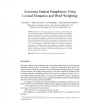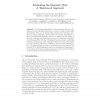55 search results - page 11 / 11 » Knowledge Lean Word-Sense Disambiguation |
AIED
2009
Springer
13 years 12 months ago
2009
Springer
We present in this paper an approach to assessing student paraphrases in the intelligent tutoring system iSTART. The approach is based on measuring the semantic similarity between ...
SEMWEB
2007
Springer
13 years 11 months ago
2007
Springer
The increased availability of online knowledge has led to the design of several algorithms that solve a variety of tasks by harvesting the Semantic Web, i.e., by dynamically select...
LREC
2010
13 years 6 months ago
2010
In the paper we investigate the impact of data size on a Word Sense Disambiguation task (WSD). We question the assumption that the knowledge acquisition bottleneck, which is known...
WISE
2008
Springer
13 years 11 months ago
2008
Springer
Semantic relatedness measures quantify the degree in which some words or concepts are related, considering not only similarity but any possible semantic relationship among them. Re...
JMLR
2011
13 years 7 days ago
2011
We propose a framework MIC (Multiple Inclusion Criterion) for learning sparse models based on the information theoretic Minimum Description Length (MDL) principle. MIC provides an...


